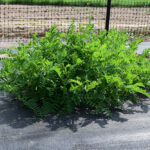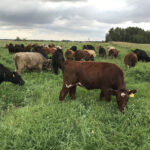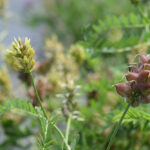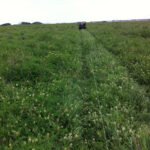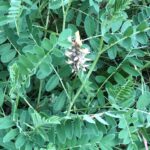Cicer Milkvetch
Astragalus cicer L.
General Description
Cicer milkvetch is a palatable, non-bloating, perennial legume.
Deeply branched taproots and tough rhizomes develop from wide, winter-hardy crowns. Stems begin growing upright but soon fall or lodge. These hollow, succulent stems can be up to 120 cm (47 in) long, growing to about half that in stand height. Compound leaves grow up to 15 cm (6 in) long, and are made up of 13 to 27 hairy, paired leaflets.
Seed heads develop from buds on the stems, while leaves keep growing. There can be up to 40 pale yellow to white flowers attached to one stem. After cross-pollination, seed pods grow up to 15 mm (1/2 in) long, turning black as they ripen. Each pod easily shatters to reveal up to 12 bright yellow to pale green seeds, which are hard and impervious to moisture.
Cicer milkvetch retains its leaves through the fall making it a popular option for stockpiled grazing. Cicer milkvetch does not accumulate toxic levels of selenium, unlike many of the other milkvetches or “loco weed.”
Type
Tame legume.
Origin
Native to Europe and Russia. Varieties developed in Canada.
Longevity
At least 10 years. Once established, allowing seed-set encourages new seedling growth.
Use
Pasture, hay, stockpiling.
Optimal Time of Use
Cicer milkvetch grows slower than alfalfa in the spring. With adequate rest, can be grazed early summer to fall. Since it holds its quality very well, it can be stockpiled for fall or winter grazing with good expected weight gains. When stockpiled it can still provide a maintenance feed before growth begins in early spring. Haying at 25% bloom maximizes quality and yield.
Recovery After Use
Recovery can occur within 45-60 days in the black and grey soil zones and 60-80 days in the brown soil zones. Cicer milkvetch can have a high rate of recovery if not grazed to less than 10 cm (4 in), and can be grazed frequently. Because of its rhizomes, it is tolerant to animal hoof action. Managed grazing improves the spread and fill of cicer milkvetch in a stand. Allowing cicer milkvetch to set seed every 3 years can keep new plants in the stand.
Palatability/Nutritional Value
Crude protein values of 14.6% and digestibility of 61.5%. It has slightly higher protein levels and digestibility than alfalfa and red clover, but less than alsike and white clover. Cicer milkvetch maintains leaves and therefore quality late into the fall. It is a non-bloat legume.
Annual Precipitation min/max (mm)
350mm / 600mm
Drought Tolerance
Moderate drought tolerance. Cicer milkvetch is known to go dormant during dry periods.
Flooding Tolerance
Tolerates up to 1-2 weeks of spring flooding. Cicer milkvetch does not tolerate more than brief periods of flooding during growing season.
Winter Hardiness
High winter hardiness. Rhizomes and vigorous crowns allow cicer milkvetch to persist in this climate.
Soil Texture Preference
Adapted to all soil texture types but prefers well-drained soils. It can tolerate soils with high water table.
Erosion Control
Moderate. Cicer milkvetch’s creeping roots (rhizomes) are effective at controlling erosion once the plant has established
Salinity Tolerance
Slight tolerance.
Acidity Tolerance
Moderate tolerance. Some varieties tolerate soil pHs as low as 6.0, while others are more tolerant when seeded in moderately acidic soils in western Canada (5.5).
Alkalinity Tolerance
Moderate tolerance.
Seeds per kg
270,000seeds/kg (122,000 seeds/lb)
Suggested Mixtures
Bunchgrasses or legumes with similar regrowth characteristics or the ability to maintain palatability are a good mixture fit. Meadow bromegrass, tall fescue, hybrid bromegrass, timothy, red clover, and smooth bromegrass have been used.
Ease of Establishment
Many sources report that Cicer milkvetch is difficult to establish but newer varieties with increased seedling vigour have improved establishment characteristics. Delayed germination of seed may continue for up to 2 to 3 years because of hard seeds. Cicer milkvetch can be established with the spread of seed by grazing animals.
Competitiveness
Very competitive once established. Cicer milkvetch has become a weedy species in roadways, field margins, and urban areas.
Management Considerations
Planting inoculated seed encourages nitrogen fixation. Allow adequate time for good establishment (i.e., up to 2 growing seasons) before using Cicer milkvetch. Allowing this species to set seed every 3 years to promote the recruitment of new plants in the stand. As cicer milkvetch photosynthesis’ from existing growth to regrow- ensure leafy residue remains after first grazing/cutting to encourage regrowth and recovery (allows for a 2nd grazing event).
British Columbia Rangeland Seeding Manual, Saskatchewan Dryland Forage Species Adaptation Tool, USDA Plants Database, Alberta Forage Manual, Manitoba Forage Adaptation and Comparison Guide
Cicer milkvetch is adapted to the Sub-Boreal Spruce, Sub-Boreal Pine-Spruce zones and Interior Cedar-Hemlock zones. In the southern part of the Central Interior it is adapted to wetter parts of the Interior Douglas-fir zone, and to irrigated and subirrigated areas in the Bunchgrass zone and dry parts of the Interior Douglas-fir zone.
Cicer milkvetch is adapted to wetter areas in the region (i.e., the Interior Cedar-Hemlock Zone and wetter areas of the Interior Douglas-fir zone) and to irrigated or subirrigated areas in the Bunchgrass, Ponderosa Pine and Interior Douglas-fir zones. Longer recovery times should be expected in dryland applications.
Cicer milkvetch is adapted to the Peace River region, but may not be widely used because it is hard to establish.
